|
Lens
|
Sony NEX E-mount 18-200mm F/3.5-6.3 OSS SEL18200
|
|
Box contents
|
Hood, front and rear caps and a user’s manual. Possibly a flash extender may be included in some kits.
|
|
Cost
|
$900 retail as of 2012
|
|
Build quality
|
Very good.
|
|
Additional information
|
Introduced in 2010. Has built-in optical image stabilization or OSS, and a focus motor inside similar to SSM, not the cheaper SAM.
|
| Specifications below |
|
|
Optical configuration
|
17 elements in 12 groups
|
|
Angle of view
|
78°-8° APS-C
|
|
Aperture
|
7 blades, curved
|
|
Full frame and APS-C
|
APS-C only, and will only mount on E body cameras. With crop factor of 1.5x the coverage equals 27-300mm.
|
|
Depth of field and focus scales?
|
Nothing.
|
|
Min. focus distance, image plane to subject @ max reproduction ratio
|
20.1″ (510mm)
|
|
Min. focus distance, end of lens barrel to subject @ max. reproduction ratio
|
12.35″ (312mm)
|
|
Hard stop at infinity focus?
|
No
|
|
Length changes when focusing?
|
No
|
|
Focus ring turns in AF?
|
No
|
|
Filter size
|
67mm
|
|
Filter ring rotates?
|
No
|
|
Distance encoder?
|
Yes
|
|
Max magnification
|
0.35x, or 1:2.85
|
|
Min. F/stop
|
F/22-40
|
|
Sony teleconverter compatible?
|
No
|
|
Length changes when zooming?
|
Yes
|
|
Dimensions WxL (my measurements)
|
3″ x 3.9″ 76mm x 99mm.
|
|
Maximum extended length (my measurements)
|
6.85″ (174mm)
|
|
Weight bare (my scale)
|
18.5oz (524g)
|
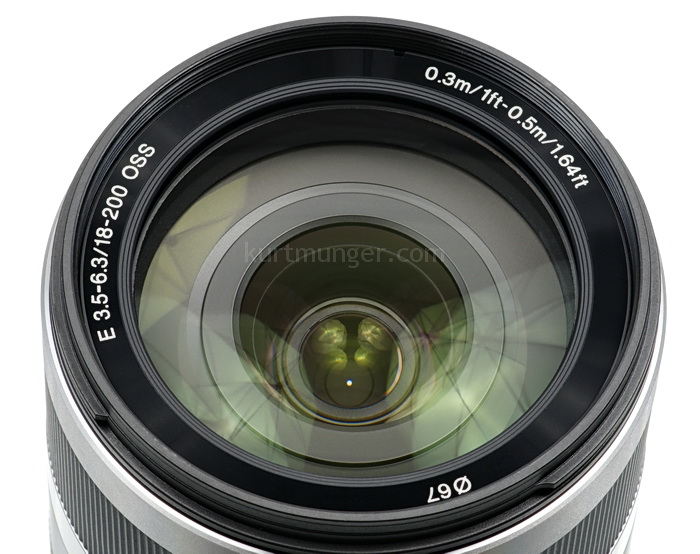 |
| Front element |
 |
| Backside mount. Notice lens bottom scuff pad in right lower corner of image |
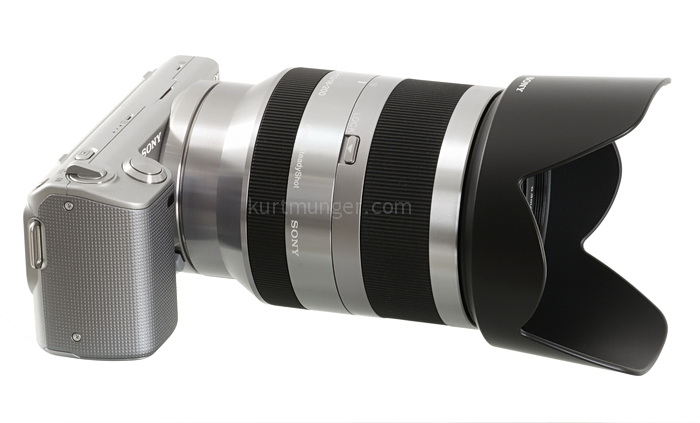 |
| NEX 5 with 18-200mm lens and included hood |
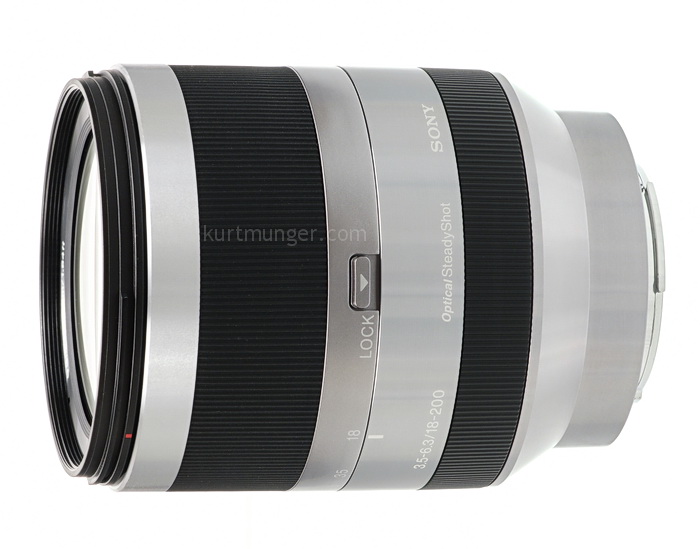 |
| Fully drawn in |
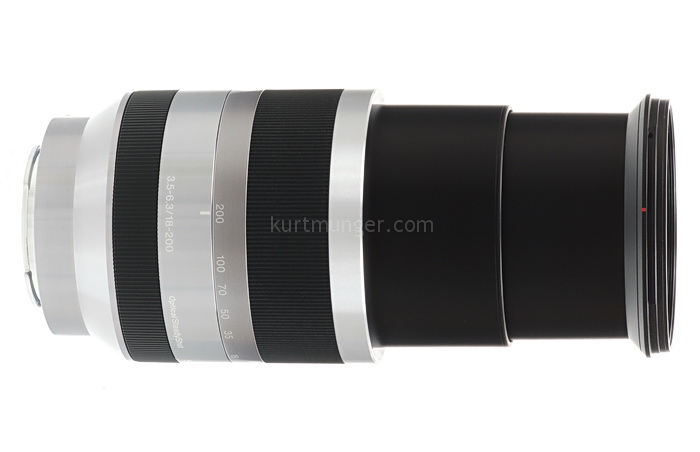 |
| Fully extended |
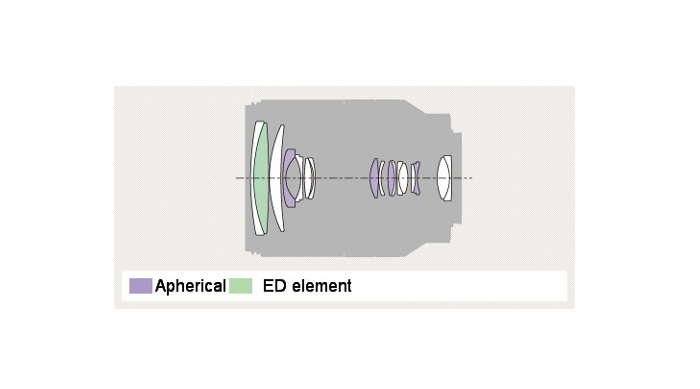 |
| X-ray view |
The NEX 18-200mm F/3.5-6.3 is the third lens to be offered in the NEX lineup for 2010, and joins the pancake 16mm, and 18-55mm F/3.5-5.6, also reviewed here. Also check out the Tamron 18-200mm for NEX, it’s different, but just as good and much less expensive. You should not mistake this lens for the Sony DT 18-200mm F/3.5-6.3, which is lighter, smaller, has a cheaper build quality, slot/screw focusing and no OSS or optical steady shot.
The NEX 18-200mm F/3.5-6.3 (Made in China) is build solidly, has a nice smooth zoom and manual focus action, along with a nearly silent auto-focus motor which is great for keeping focus noise out of movies. You’ll also notice the OSS, or optical steady shot, built into the lens. Sony and Minolta AF (a-mount) lenses have no image stabilization, instead, Sony uses in-camera body sensor-shift type image stabilization. Sony claims the use of four aspherical elements and one ED element inside, see the last product shot above.
Fit and finish are very good. The lens appears to be clad in metal, although it does have a two piece plastic extension tube, lower zoom ring and filter ring. This lens sports a metal mount, a zoom lock switch, and a black scuff pad on the underside. The color is silver, like stainless steel, with a slightly off-color plastic lower focus zoom ring. Focus and zoom rings have the typical Sony black rubber close-ribbed design.
 |
| 18mm, strong barrel distortion |
 |
| 200mm, moderate pincushion distortion. |
Aperture/focal length guide.
|
Maximum aperture
|
F/3.5
|
F/4
|
F/4.5
|
F/5
|
F/5.6
|
F/6.3
|
|
Range
|
18mm
|
18mm – 26mm
|
27mm – 37mm
|
38mm – 49mm
|
49mm – 134mm
|
140mm – 200mm
|
|
18mm F/3.5
|
18mm F/5.6
|
 |
 |
|
200mm F/6.3
|
200mm F/8
|
 |
 |
Bokeh is somewhat harsh at both ends with a wide open aperture, producing a noticeable ring and point in highlights, that’s typical for less expensive zooms. If you close the aperture one stop, it gets a little smoother. At closer focusing distances, say less than 5-10′ (1.5-3.0m) it’s sometimes smooth and good looking at both ends. Crops are from the center of the image, about 10′ to 20′ (3m-6m) behind the focus point at close to medium distances, less than 50′ or 15m.
The full image below shows what you can expect when you shoot close objects with the background farther off, especially zoomed out. The background blur is pretty smooth here, but most lenses will show a smooth highlight blur in certain situations.
 |
| 200mm, F/8 full image |
|
18mm F/3.5
|
18mm F/5.6
|
 |
 |
Coma is not of concern with this lens at any aperture or focal length.
|
18mm F/5.6 sun out of image
|
36mm F/5.6 sun out of image
|
 |
 |
|
18mm F/5.6
|
64mm F/5.6
|
 |
 |
|
18mm F/5.6 rings when sun is centered
|
18mm F/5.6 sun out of image
|
 |
 |
When you wave the camera around in the sun, funny things show up, this is very noticeable in cameras with live-view. At the bottom, I see some circles when you point the lens at the sun at the wide end, that’s a bit weird, as this usually happens with older designed lenses. Why would you point the lens directly into the sun you ask? Well, sunset shots would be one good example, everyone does that right? I also see some magenta flare when the sun is at the edge of the image at a certain point, again, noticeable and reproducible when using live-view. There is some flare and ghosting when the sun is out of the image at all focal lengths. The supplied hood will take care of some of it, but using your hand to block the sun is the most effective method. It’s easy to see this type of stuff by keeping an eye on the LCD, and checking your shots. The NEX 18-200mm lens is not quite as good at eliminating ghosting as the 18-55mm NEX lens.
The NEX 18-200mm is about average at flare and ghosting control. I’m showing the issues above just to let you know what might happen if you wave the camera around and take pictures with the sun or very bright light near, or inside the image.
|
18mm F/3.5
|
18mm F/5.6
|
 |
 |
|
200mm F/6.3
|
200mm F/8
|
 |
 |
|
200mm F/6.3
|
200mm F/8
|
 |
 |
Below are crops from the image centers at 18mm.
|
F/3.5
|
F/5.6
|
 |
 |
|
F/8
|
F/11
|
 |
 |
|
F/3.5
|
F/5.6
|
 |
 |
|
F/8
|
F/11
|
 |
 |
At the mid-section, F/3.5 is soft, but closing the aperture a stop or two sharpens the image to nearly meet the center sharpness levels. Again, diffraction sets in at F/11.
Below are the corners at 18mm.
|
F/3.5
|
F/5.6
|
 |
 |
|
F/8
|
F/11
|
 |
 |
 |
| 18mm, F/5.6 extreme left side at middle of image |
 |
| 200mm, F/8 extreme right side at middle of image |
Below are some boring (and unfortunately now standard) stamp crops taken indoors to reduce the chance of heat shimmer, haze and other issues that come from trying to test shoot a subject at long distances. The distance in this section is 27′ 3″ or 8.3m from the end of the lens barrel to the stamp. That’s about the same distance as you might be from a bird or (head shot) people pictures. It’s more valuable, and replicates real life better than a close focus Imatest type shot in my opinion.
|
F/6.3
|
F/8
|
 |
 |
|
F/11
|
F/16
|
 |
 |
|
F/6.3
|
F/8
|
 |
 |
|
F/11
|
F/16
|
 |
 |
At the mid-section, F/6.3 is blurry, but stopping down to F/11 really improves the shot.
Below are the corners at 200mm.
|
F/6.3
|
F/8
|
 |
 |
|
F/11
|
F/16
|
 |
 |
Comparisons with the Sony 70-200mm F/2.8 G lens @200mm.
|
NEX 18-200mm center, F/8
|
Sony 70-200mm center, F/8
|
 |
 |
|
NEX 18-200mm center, F/8 contrast and sharpness added
|
Sony 70-200mm center, F/8, same image as above
|
 |
|
|
NEX 18-200mm corner, F/11 no adjustments
|
Sony 70-200mm corner, F/11
|
 |
 |
The crops above were taken at 200mm, at a distance of 27′ 3″ or 8.3m from the end of the lens barrel to the stamp. Obviously, this isn’t a fair test between lenses, but it does show the lack of contrast of the 18-200mm at the end of the zoom. As you can see, the actual resolution is pretty good on the NEX super zoom, but the edge transitions, or acutance is not so great as compared to the expensive Sony G lens. In the left column of the second row, I’ve added a heavy amount of contrast and sharpness to the NEX crop to try and make it look more like the Sony G crop. It does look better, but if you look carefully at the bell highlights details, and text “Twenty first class stamps” you’ll see the NEX lens still can’t produce the same sharp delineation as the Sony G lens. The corner crops are worlds apart. Of course the Sony 70-200mm G lens was made for a full frame sensor or 35mm film, and the small APS-C sensor is only using the central area of the lens, that’s why there’s a huge difference between the corner crops, but I said it wasn’t a fair test. There’s a little moire visible in the stamp UPC lines of the Sony G, but that’s not really a lens issue.
The Sony 70-200mm was tested using the A700, and has a sensor count deficit of 2mp, that’s why the stamp looks smaller in those crops. All crops have the same exposure values.
Now for the conclusion.
The Sony NEX 18-200mm F/3.5-6.3 OSS lens is fairly expensive, but provides a very useful focal range, making it super convenient. Does the lens do a good enough job to warrant the $900 price tag? Read on.
The big NEX E-mount super-zoom lens turned in a decent review over-all. Oddly, the most notable characteristic is probably the build quality and feel, it’s very nice, and much more so than the typical Sony alpha branded lenses. The next most notable feature is the actual resolution, it’s pretty high, especially at the short end, with the whole image exhibiting good contrast at F/5.6-8. Unfortunately, as you zoom out, the contrast erodes rapidly, and you’re left with the typical super-zoom (slightly washed out) look. There are some other areas where the lens could do better, like the macro shot; poor for an $800 lens, and color fringing, which is too much, but typical for a super-zoom.
Thoughts on actual use; The Sony NEX 18-200mm F/3.5-6.3 is a fairly large lens, and as such, seems very awkward on the diminutive NEX-5. Whenever I grip the camera hard with my right hand, while using my left for manual focusing or zooming, I find myself inadvertently pushing buttons on the right side of the camera, either the movie button or the control wheel. The camera is just too darn small! Unfortunately, that’s reality with a heavy lens on a tiny camera with a tiny hand grip. Another complaint is the less than stellar focusing on the long end, especially close-up. Sometimes it won’t focus at all, but will allow the shutter to actuate, resulting in a wasted picture. One thought might be since the lens lacks contrast on the long end, the contrast detection focusing system simply doesn’t have enough contrast to work with, who knows.
I’d highly recommend this lens when used for video, in which case you won’t notice the soft images at the long end, because HD video is only good for a max of about 2mp, at high compression.
Dont’ forget to check out the review of the Tamron (NEX) 18-200mm Di III VC, which is smaller, lighter and less expensive than the Sony 18-200mm NEX.
